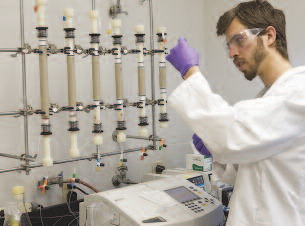Scientists tracking the spread of pathogens in groundwater, and homebuilders seeking a safe distance from septic system to water well, ask the same question: How far do bacteria travel through porous media like soil?
Applying the collision efficiency – the probability that bacteria will adhere to a surface with which it comes into contact – can answer part, but not all, of that question, says Derick Brown, the Frank Hook Assistant Professor of civil and environmental engineering.
Varying cell surface properties affect bacterial transport, says Brown, making the collision efficiency a distributed, not a fixed, parameter. Brown, who has an NSF CAREER Award, studies aspects of bacterial transport through sand packed in columns at multiple-length scales.
“We have worked with columns of up to 1 meter in length,” says Brown, “and we plan to set up a 10-meter flow system. By measuring bacteria concentrations and transport conditions along the 10 meters, we hope to enhance our understanding of the collision efficiency distribution and its effects on bacterial transport under near field-scale conditions.”
Brown also studies the correlation between acid-base cell properties and enhanced production of adenosine triphosphate (ATP), which is a key energy carrier for living organisms. He is modeling the link between the neutralization of a cell’s acidic surface, as it approaches another surface, and the formation of ATP. This research seeks to improve understanding of a well-known phenomenon – the increase in metabolic activity of a bacteria cell when the cell adheres to a solid surface.

